Patio Privacy Screens; Creating a private retreat on your patio can transform your outdoor space into a serene escape from the hustle and bustle of daily life. Whether you’re looking to shield yourself from prying eyes or simply want to add a touch of intimacy to your outdoor area, a well-chosen privacy screen can make a significant difference. From DIY projects that allow for personalized creativity to stylish store-bought options that offer convenience, there are numerous ways to enhance your patio’s privacy. In this guide, we explore 11 easy patio privacy screen ideas, blending both homemade and ready-made solutions to suit your needs and style. Whether you’re a seasoned DIY enthusiast or prefer the ease of purchasing pre-made screens, you’ll find plenty of inspiration to create a secluded sanctuary right in your own backyard.
1. Fabric Panels: A Simple and Affordable Option

Fabric panels are a budget-friendly and straightforward way to create privacy on your patio. They come in various colors, patterns, and sizes, allowing you to personalize your space. Opt for weatherproof and UV-resistant fabrics specifically designed for outdoor use. These materials are built to withstand the elements and won’t fade in the sunshine.
There are several ways to hang your fabric panels. You can use a simple curtain rod attached to your patio roof or wall. Alternatively, install sturdy hooks on your patio structure and hang the panels directly. For a more contemporary look, consider using tension cables with hooks to create a sleek, streamlined appearance.
Here are some additional tips for using fabric panels:
- Double up on fabric panels: If you require a higher level of privacy, consider hanging two layers of fabric panels. This will create a more opaque barrier and block out even more light.
- Play with patterns and colors: Don’t be afraid to experiment with colors and patterns! Choose fabrics that complement your existing patio furniture and décor. Bold stripes or floral prints can add a touch of personality, while solid-colored fabrics create a more understated look.
- Consider weighted hems: If you live in a windy area, opt for fabric panels with weighted hems. This will prevent them from flapping in the breeze and creating noise.
2. Reed Screens: Natural Beauty Meets Functionality
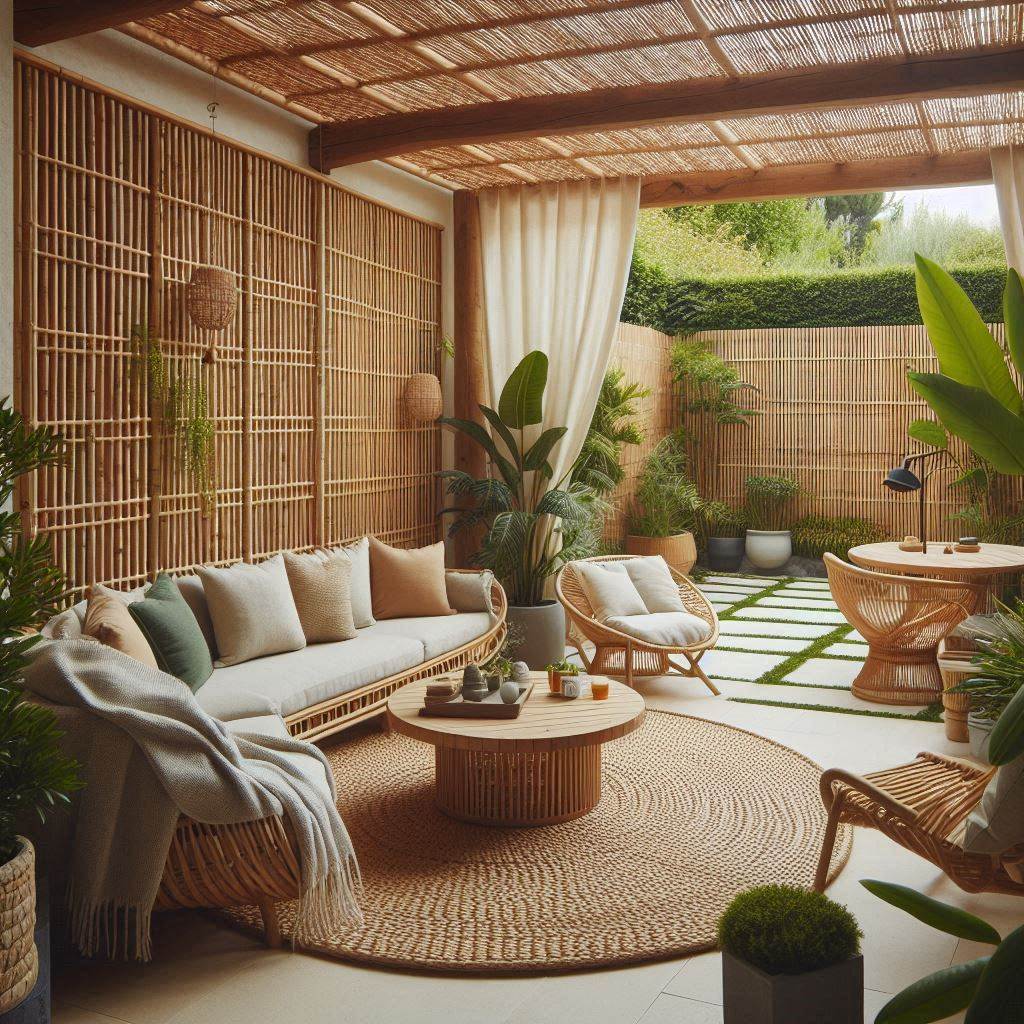
Reed screens offer a beautiful and eco-friendly solution for patio privacy. Made from natural materials like bamboo or reeds, these screens add a touch of organic charm to your outdoor space. They also provide a good level of privacy while still allowing for some airflow.
Reed screens come in various sizes, so you can easily find one that fits your patio dimensions. They’re typically lightweight and easy to install, often requiring only screws or hooks to secure them to your patio structure.
Maintaining your reed screens is relatively simple:
- Regular dusting: Use a soft brush to remove dust and cobwebs from your reed screens periodically.
- Occasional cleaning: For a deeper clean, you can hose down the reed screens with water, ensuring they dry completely afterwards.
- Rejuvenating the color: Over time, reed screens may lose their natural color. You can revive them by applying a light coat of clear sealant specifically designed for outdoor use.
3. Climbing Plants on a Trellis: A Long-Term Investment with Living Beauty
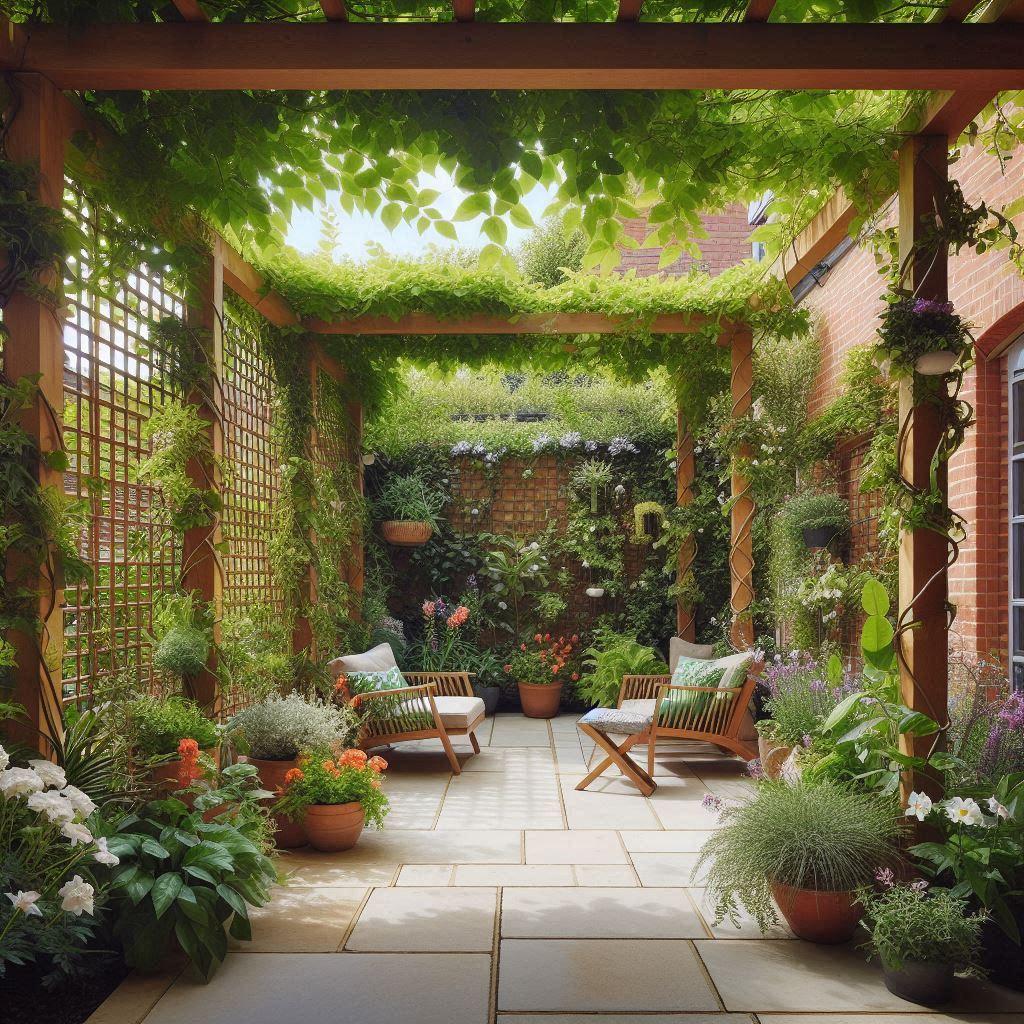
Climbing plants on a trellis are a stunning and sustainable way to create privacy on your patio. This option offers the benefits of both privacy and natural beauty. As the plants grow, they will provide a lush screen that filters sunlight and creates a cool, inviting atmosphere. Plus, watching your plants thrive adds a touch of serenity to your outdoor space.
Here’s what you need to consider when choosing climbing plants:
- Climate zone: Select fast-growing vining plants that are well-suited to your climate zone. Research their sun and water requirements to ensure they thrive in your patio environment.
- Maintenance: Some climbing plants require more maintenance than others. Choose varieties that are easy to care for and don’t require extensive pruning.
Building a simple trellis for your climbing plants is a straightforward DIY project. Here’s a basic approach:
- Materials: Choose weather-resistant wood or metal for your trellis. You’ll also need screws, nails, and a saw.
- Construction: Build a rectangular frame and then add horizontal or diagonal slats to create a grid-like structure for the plants to climb.
- Installation: Secure the trellis to a wall or fence on your patio, ensuring it’s strong enough to support the weight of mature plants.
4. Privacy Fence Panels: A Quick and Easy Solution

For those seeking a readily available and easy-to-install option, pre-made privacy fence panels are a great choice. These panels come in various materials like wood, vinyl, and metal, offering a range of styles and price points.
Here’s a breakdown of the pros and cons of each material:
- Wood:
- Pros: Provides a classic and natural aesthetic, can be stained or painted to match your décor.
- Cons: Requires regular maintenance (staining or sealing) to prevent rot and warping.
- Vinyl:
- Pros: Low maintenance, comes in various colors and styles, resistant to weather damage and fading.
- Cons: Can appear less natural-looking compared to wood, may not be as strong as wood in some cases.
- Metal:
- Pros: Very durable and weather-resistant, low maintenance, modern and sleek look.
- Cons: Can be expensive, may get very hot in direct sunlight.
Installing pre-made privacy fence panels is a relatively straightforward process. Most panels come with pre-drilled holes and instructions for easy assembly. You’ll typically need to secure the panels to posts that are anchored into the ground.
Here are some additional tips for using privacy fence panels:
- Consider the height: Choose panels that provide the desired level of privacy for your patio. Remember to check any local regulations regarding fence height restrictions.
- Spacing between panels: Leave a small gap (around half an inch) between each panel to allow for air circulation and prevent warping.
- Adding decorative elements: You can customize your privacy fence panels by adding decorative elements like planters with trailing plants or hanging lanterns for a touch of ambiance.
5. Pallet Privacy Wall: A Budget-Friendly DIY Project
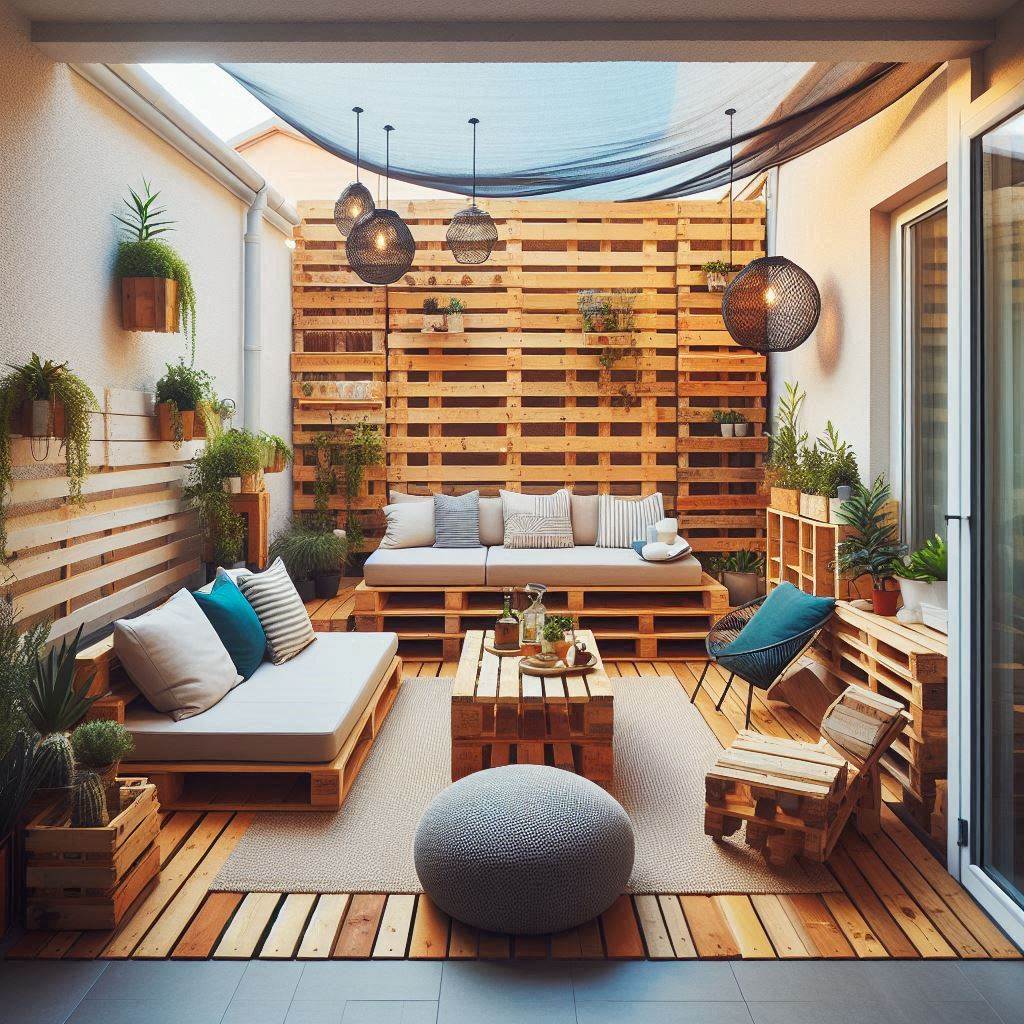
Calling all DIY enthusiasts! Pallet walls are a budget-friendly and trendy way to create a unique privacy screen for your patio. Pallets are readily available (often for free) and offer a rustic and industrial aesthetic.
Here’s how to create a pallet privacy wall:
- Sourcing pallets: Look for used pallets in good condition. Ensure they are free of splinters, nails protruding from the wrong side, and any hazardous materials.
- Preparing the pallets: Sand down any rough edges and remove any unwanted nails or staples. You can also choose to stain or paint the pallets for a specific look.
- Building the wall: Decide on the layout for your privacy wall. You can stack the pallets vertically or horizontally, or create a more intricate design. Secure the pallets together using screws or nails.
- Installation: Depending on the weight and size of your finished wall, you may need to secure it to your patio structure or fence for added stability.
Here are some additional tips for building a pallet privacy wall:
- Use gloves and safety glasses: When working with pallets, it’s important to wear gloves and safety glasses to protect yourself from splinters and flying debris.
- Consider adding lighting: String lights or fairy lights woven through the pallet slats can create a magical ambiance in the evenings.
- Incorporate planters: Decorate your pallet wall with hanging planters or small shelves for potted plants, adding a touch of greenery and life to your patio.
6. Outdoor Curtains: Luxurious Style Meets Practicality
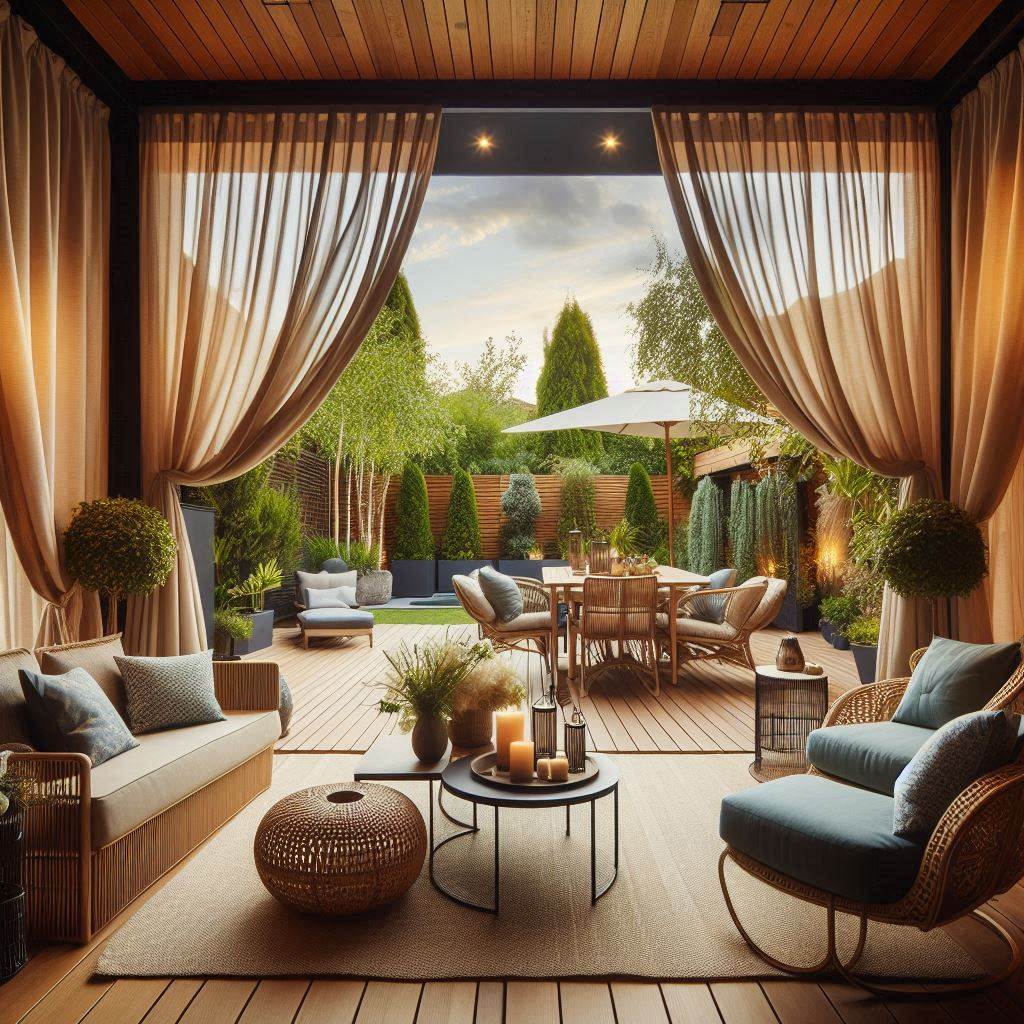
Outdoor curtains offer a luxurious and versatile option for creating privacy on your patio. They come in various fabrics, colors, and patterns, allowing you to customize your space and create a sophisticated atmosphere.
When choosing outdoor curtains, consider these factors:
- Material: Opt for weather-resistant fabrics specifically designed for outdoor use. These materials are typically water-repellent, fade-resistant, and mildew-resistant.
- Weight: Choose a fabric weight that suits your needs. Lighter fabrics provide a more sheer look and allow for some light filtration, while heavier fabrics offer a higher level of privacy and can even block out some wind.
- Functionality: Outdoor curtains can serve multiple purposes. They can provide privacy, block out sunlight for shade control, and even add a touch of insulation on cooler evenings.
Installing outdoor curtains is similar to hanging indoor curtains. You can use a sturdy curtain rod attached to your patio roof or wall. Ensure the rod can support the weight of the chosen fabric.
Here are some additional tips for using outdoor curtains:
- Tiebacks for versatility: Use tiebacks to hold back your outdoor curtains when you want to enjoy an open-air feel on your patio.
- Consider layering: Layer sheer outdoor curtains with blackout curtains for ultimate privacy and light control.
- Weighted hems: If you live in a windy area, choose outdoor curtains with weighted hems to prevent them from flapping in the breeze.
7. Privacy Screen with Lights: Enhance the Ambiance
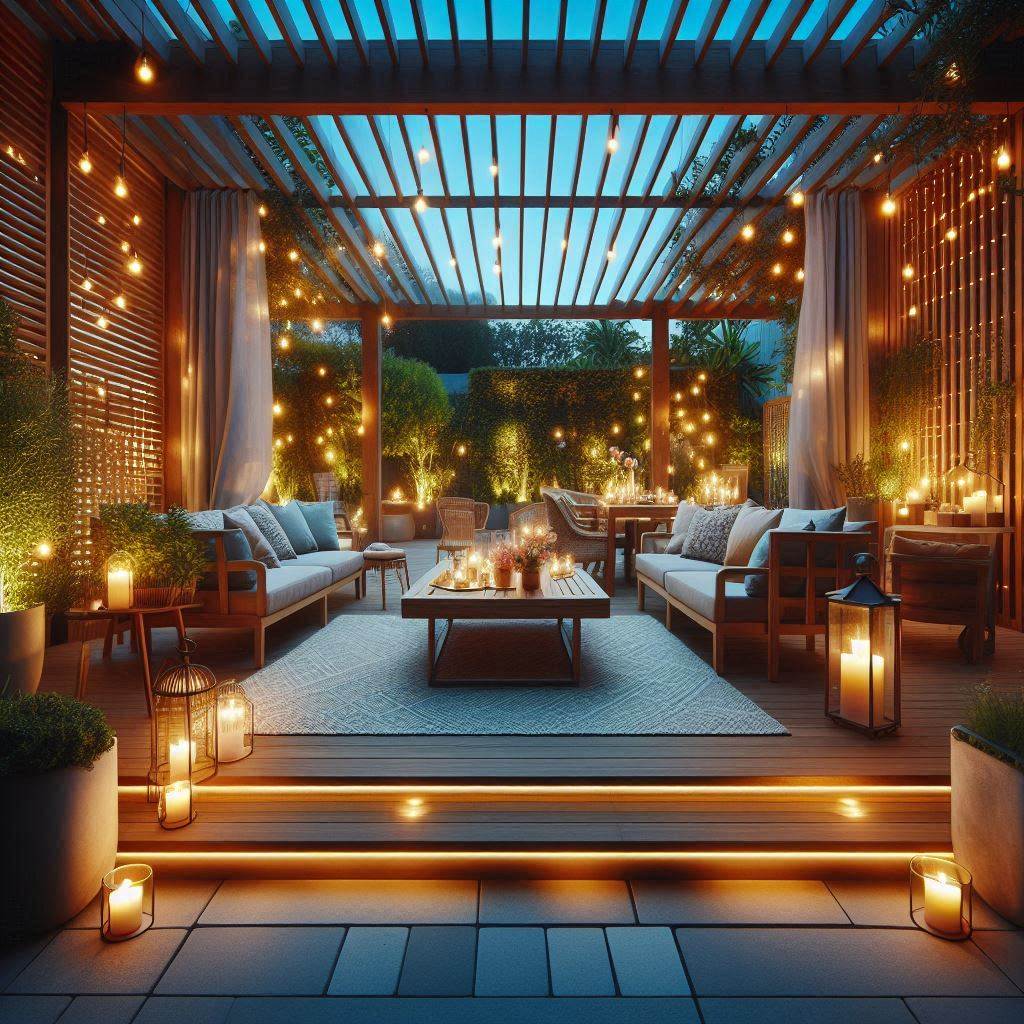
Take your patio privacy screen to the next level by incorporating outdoor lighting. String lights, fairy lights, solar lanterns, or even spotlights can create a magical ambiance and add another layer of functionality.
Here are some ideas for incorporating lighting into your privacy screen:
- String lights: String lights are a classic and versatile option. They can be draped across the top of your privacy screen, woven through slats in a pallet wall, or hung along the sides of fence panels. Choose warm white or colored lights depending on the desired mood.
- Fairy lights: For a more whimsical touch, consider using fairy lights. These tiny lights create a soft, twinkling effect and are perfect for creating a romantic atmosphere on your patio.
- Solar lanterns: Solar lanterns are an eco-friendly and low-maintenance option. They come in various styles and can be hung on your privacy screen or placed on the ground nearby.
- Spotlights: If you want to highlight specific areas of your patio or create a more dramatic effect, consider using spotlights. These can be strategically placed near or behind your privacy screen to illuminate plants, sculptures, or water features.
Here are some additional tips for lighting your patio privacy screen:
- Power source: Choose lighting options that best suit your needs. Solar-powered lights are convenient and require minimal maintenance, while traditional electric lights offer more flexibility in terms of brightness and control.
- Safety: Ensure all electrical wiring and connections are weatherproof and meet safety regulations.
- Dimmers for ambiance: Consider using dimmers for your outdoor lights. This allows you to adjust the brightness and create a variety of moods on your patio.
8. Freestanding Privacy Panels:
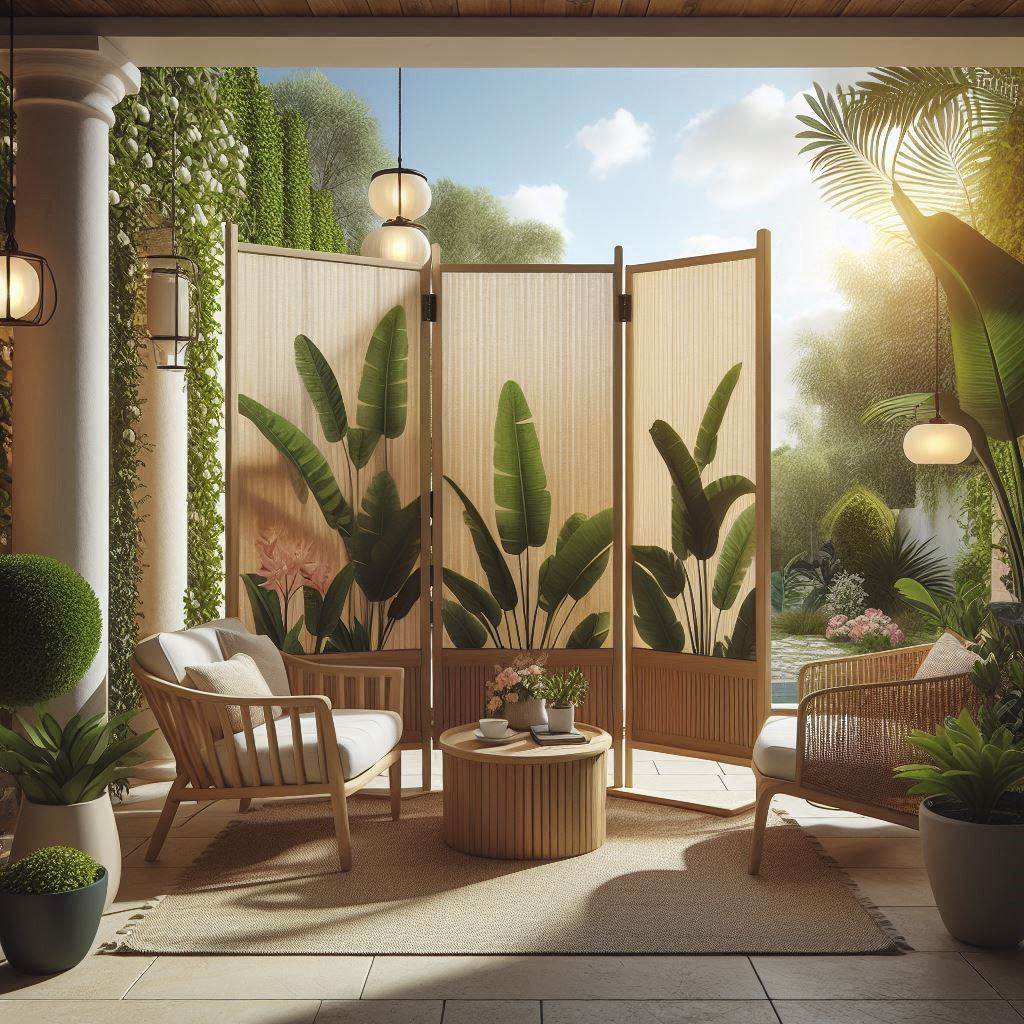
For a versatile and movable option, consider freestanding privacy panels. These panels come in various materials like wood, metal, or weatherproof fabric stretched over a frame.
- Benefits:
- Flexibility: Freestanding panels offer the advantage of being easily repositioned. You can adjust their location based on the sun’s direction or rearrange them to create different configurations on your patio.
- Double duty: Some freestanding panels come with built-in planters, allowing you to combine privacy with a touch of greenery.
- Things to Consider:
- Stability: Ensure the panels are weighted or secured to the ground, especially if you live in a windy area.
- Size and style: Choose panels that complement the size of your patio and match your overall aesthetic.
9. Privacy Screen with Climbing Vines on a Retractable Awning:
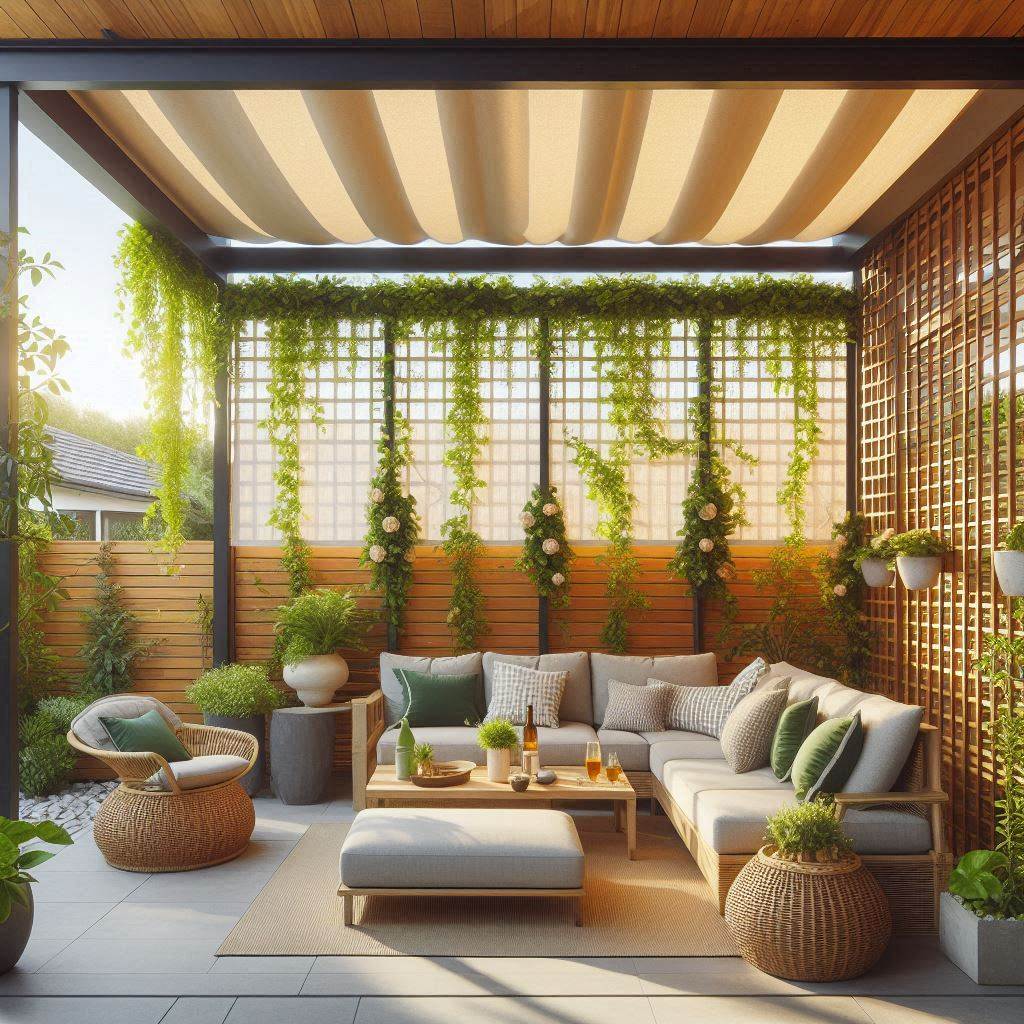
This option combines practicality with a touch of natural beauty. Install a retractable awning on your patio roof and train climbing vines to grow on it.
- Benefits:
- Dual Functionality: The retractable awning provides shade control on sunny days while the climbing vines offer privacy and a natural aesthetic.
- Space-saving: This solution utilizes vertical space effectively, making it ideal for smaller patios.
- Things to Consider:
- Awning weight capacity: Ensure the awning can support the weight of the climbing vines and any additional planters.
- Vine selection: Choose fast-growing, lightweight vines that are well-suited to your climate zone.
10. Privacy Screen Made from Recycled Materials:

Calling all eco-conscious DIY enthusiasts! This option allows you to create a unique privacy screen while being kind to the environment.
- Materials: Get creative! You can use various recycled materials like old shutters, doors, or even pallets (as mentioned earlier).
- Benefits:
- Sustainability: Reusing discarded materials reduces your environmental impact.
- Unique aesthetic: A recycled materials privacy screen can add a touch of personality and charm to your patio.
- Things to Consider:
- Preparation: Ensure all recycled materials are cleaned, sanded, and prepped for outdoor use. You might need to apply paint or sealant for weatherproofing.
- Structural integrity: Choose materials that are sturdy enough to create a stable privacy screen.
11. Decorative Privacy Screen with Hanging Planters:
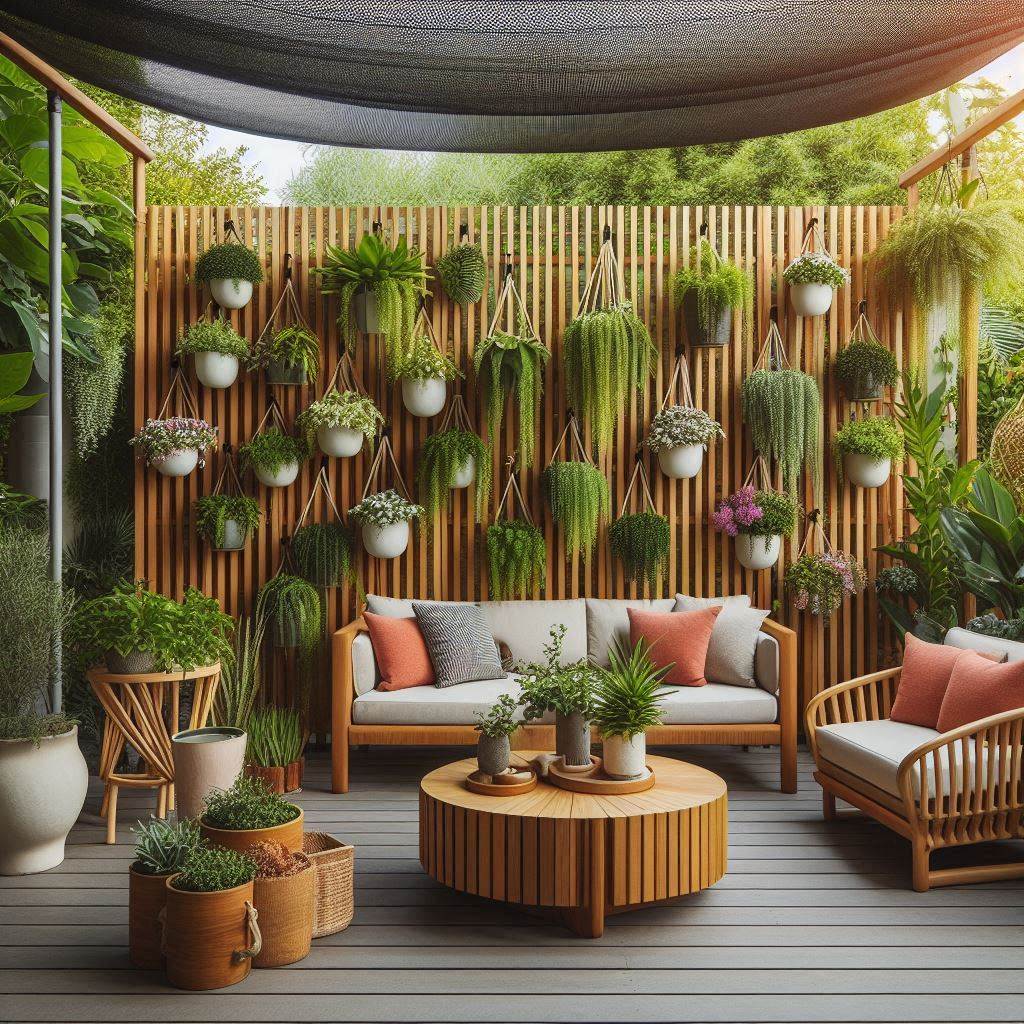
This option offers a beautiful and low-maintenance solution for creating a soft visual barrier on your patio.
- Materials: Use a metal frame or a sturdy trellis as the base for your privacy screen. Decorate it with a variety of hanging planters filled with cascading plants or colorful flowers.
- Benefits:
- Low maintenance: Hanging planters require minimal maintenance compared to solid privacy screens. You can easily swap out plants based on the season or your preferences.
- Airy and inviting: This option creates a visual barrier without completely blocking out sunlight or air circulation.
- Things to Consider:
- Drainage: Ensure your hanging planters have proper drainage holes to prevent waterlogging.
- Plant selection: Opt for trailing plants like vines, ferns, or cascading flowers that will visually soften the space.
Wrapping Up
Adding a privacy screen to your patio is a simple yet effective way to create a more comfortable and private outdoor space. With these 11 easy ideas—ranging from DIY projects that let you customize your privacy solution to stylish store-bought options that deliver instant results—you can enhance your patio’s functionality and aesthetic appeal. By selecting the right privacy screen, you’ll not only boost your outdoor enjoyment but also add a personal touch to your garden or patio. So, whether you choose to build your own screen or invest in a ready-made solution, these ideas will help you achieve the perfect balance of privacy and style in your outdoor haven.

